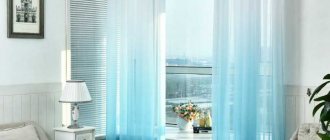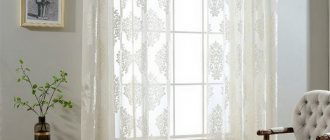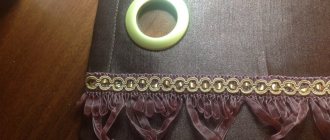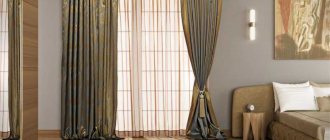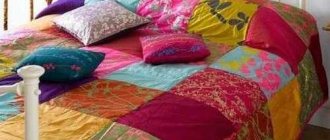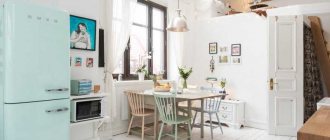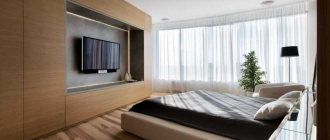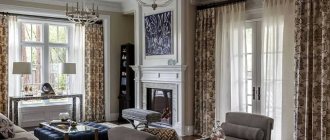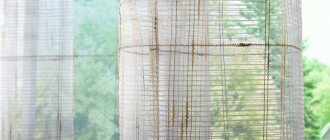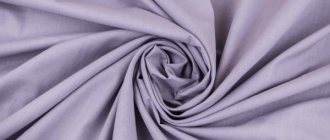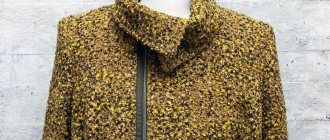Textiles serve to create a complete image of the room, where tulle plays an important role. The drapery, color and length make the interior look different even though the furniture and wall color remain the same.
Choice
The choice of curtains must be approached responsibly. At first glance, it seems that the tulles are all similar, and it doesn’t really matter which one to choose. Photos of tulle in the interior, which can be seen on the Internet, do not convey all the features of the fabric and pattern.
In fact, all tulles are made of different quality, from different materials; their choice largely depends on the interior of the room and the taste preferences of the buyer.
Please pay attention to some nuances:
- For dark and colorful curtains, it is better to choose light tulle without patterns;
- A window with an adjacent balcony door can be decorated with asymmetrical tulle;
- Bright tulle will be an appropriate accent in a room where there are many elements of brown, gray or beige.
An interior without tulle looks empty and flat. Don't neglect this element of room decoration.
Net
An extremely popular material for decorating windows. The mesh can be large, medium and barely noticeable, with a distinct structure or completely smooth. The main advantage of meshes is versatility.
Such curtains are perfect for any interior. Tulle mesh does not need ironing. After washing, it is enough to hang it on the curtain rod and it will sag under the weight of its own weight.
Materials
Most often, tulle is sewn from light, thin fabrics that allow air and color to pass through. It can be organza, mesh, muslin or veil.
Organza is a durable material that is made by twisting several threads. This canvas is not afraid of dust. Organza can be made from silk or synthetic fabrics.
Veil is a universal material that is soft and tender. It is less transparent. The veil is made from silk, cotton, polyester or wool.
Kisey is a light cotton fabric. It is transparent, has a perforated structure, consists of individual threads, and is a mesh. This fabric has to be washed more often, as dust particles accumulate in it, but it can be washed in a washing machine. The fabric allows sunlight and fresh air to pass through.
Combining fabrics
Having decided on the color, you can begin choosing the material. The appearance, texture and density of the fabric depend on the style, purpose of the room and the required level of darkness. It is worth considering the reliability of the cornice, because dense fabrics are quite heavy. And if you intend to drape your curtains, this narrows your choice even further, since not every fabric lays nicely in folds.
Classic interiors are suitable for velvet, jacquard, brocade, country style - lace tulle, cotton, chintz, linen, and high-tech is unimaginable without metallized threads and clear geometric lines.
If curtains for the living room must be impressive, then in the kitchen the indicator of endurance, resistance to odors, water and dirt is more important.
There are several ways to join fabrics for curtains:
- horizontal – a horizontal additional stripe is sewn to the main color;
- vertical - the curtains are sewn to each other vertically, or the composition consists of unconnected canvases of different widths, and the narrower ones serve as edging or tiebacks;
- perimeter - a narrow edging is sewn to the main fabric, which is often used in modern style;
- corset - fabric with lacing and ribbons is sewn in the middle of the main fabric, expanding and narrowing as it is tightened.
Double (double-sided) curtains will be a beautiful and practical window decoration. These are two canvases that are sewn, for example, from shiny and matte fabric, which can be hung on either side. The contrasting backing material is opened using tiebacks, clips or magnets.
Combined curtains of two colors - short over long, sliding and Roman, thread curtains and roller blinds - another way to combine fabrics. You can combine materials using the same pattern or accessories. For example, Roman blinds will share rich colors with curtains using tiebacks, fringes or frills.
Important: when combining different fabrics, make sure that they will look the same after washing - they will not stretch, shrink or fade. While the latter will give you something like handmade gradient curtains, consider purchasing ready-made ombre curtains.
Now is the time to move on to how curtains of two colors will look in the living room, bedroom and other rooms of the house.
Weaving types
According to the type of weaving, they are distinguished:
Note!
- Curtains for windows - TOP 120 photo and video examples. Styles and shapes of curtains, their differences. Advantages and disadvantages of window curtains
- DIY curtains - instructions for sewing curtains with your own hands. Types of fabrics, colors and patterns for curtains. 120 photos + video reviews
- Photos of curtains: design of curtains of different sizes and lengths. Color range, types of materials, patterns and curtain fastenings (photo + video)
Batiste is a soft and smooth fabric. It consists of thin fibers that are tightly twisted. Patterns are often embroidered on it.
Jacquard is a durable fabric with a relief created by weaving threads of different thicknesses. Chiffon does not deform and is not difficult to care for. This type of weaving looks advantageous on windows that face north. It is better to combine it with plain curtains.
Chiffon is a textured fabric that is usually decorated with additional elements - bows, ribbons or flowers.
What types of tulles are there?
Tulle is a general term. Tulle is a translucent and transparent, delicate, light, flowing fabric. This term refers to smooth, mesh or woven patterned fabrics, here are some of their varieties:
- lace is an openwork textile with an interweaving of natural or synthetic threads in the form of an elegant pattern, the elements of which are interconnected, without a fabric base, the openwork elements rhythmically alternate with a dense pattern;
- guipure (French lace) - openwork airy fabric with a lace pattern on a mesh;
- organza - elastic transparent or translucent fabric made of synthetic fibers, with shine and shimmer;
- crystallon - a type of organza, thin, light, translucent fabric, durable, elastic;
- veil - translucent delicate fabric made of the finest silk or cotton threads;
- chiffon (nylon) - thin transparent fabric made of natural or artificial silk;
- crepe chiffon - matte, airy, translucent, but denser fabric made from natural or mixed raw materials, rough to the touch but slippery;
- mesh, or tulle - a transparent fabric of cellular weave made of natural or synthetic threads, with cells of different sizes and shapes;
- gossamer - an airy thin transparent fabric made of synthetic fibers of various weaves;
- linen tulle - fabric made from thin linen threads or mixed fibers;
We also recommend: How to create a harmonious combination of curtains and interior
- cambric is a soft, light, translucent fabric made of very thin cotton or linen, or mixed fibers;
- header - fabric made of natural, synthetic or mixed fibers, the surface is crinkled and cannot be smoothed out;
- “Rain” tulle is a type of light, airy fabric in which thickened threads are woven into a thin base, creating the illusion of thin streams of rain.
There are many more varieties of each of the above types of tulle fabrics. In addition, they can be produced with additional decorative elements: embroidery, hemstitching, lurex, sequins, rhinestones, photo printing, etc.
In addition, tulle textiles are produced with a smooth or textured surface. Smooth tulle fabric consists only of uniform thin threads. Textured tulle is a variety of lace, patterned, and mesh fabrics.
Colors
White tulle in the interior never loses its popularity. This is due to the fact that the translucent fabric is white:
- It seems light and airy. There is a feeling that the room is “breathing” and becomes fresher. This tulle makes the room visually wider;
- Combines with fabrics of any colors, with designs and patterns, with any style;
- Does not delay light, but only slightly diffuses it, making the lighting softer;
- Universal in many ways.
In the 21st century, white tulle is not the only option. Modern designers have found a lot of interesting variations in window design using tulle of different colors.
Pastel-colored tulle is combined with bright curtains; bright tulle can become an independent decorative element that creates an accent on the window.
Note!
- Organza tulle: advantages and disadvantages of the material. Varieties of tulle and fastenings. Tips for sewing and installation (photo + video)
- Tulle design - TOP 130 photos + video reviews of tulle designs. Features of choosing fabric, length, quantity and type of tulle
- Gray tulle: nuances of using gray tulle in the interior. Suitable gray fabric materials. 150 photos + video examples
Cream, beige or sand tulle can easily fit into almost any interior. For those who like to bring the most daring ideas to life, tulle is made in golden and silver colors.
A children's room allows you to decorate the interior with peach, lavender, lemon or light green tulle.
Yellow tulle creates a win-win combination with blue and green curtains.
How to decorate a narrow window?
When decorating narrow windows, it is better to avoid heavy structures - lush lambrequins, heavy curtains, ruffles, voluminous folds and wide cornices that “cut” the window. The material should be dense, but not hard, it should flow and brighten up the narrowness of the window opening. Decor for narrow windows is chosen taking into account the following rules:
- using a minimal amount of material - lush double tulle is best left for rooms with large windows;
- decorating a high window with colored contrasting tulle or material with horizontal patterns;
- the use of small one-sided lambrequins with tulle to hide the large distance between the window and the ceiling;
- the use of light curtains, which are secured on one side with ribbons or braid;
- the use of Austrian curtains with scalloped folds made of airy but dense material (especially important for kitchens).
Hourglass curtains
When decorating tall narrow windows in the French style, you should take a closer look at the hourglass curtains (see photo). In this case, the material is fixed on the bottom and top sides of the window using fishing line, thread or Velcro so that tension is created in the fabric, and tied in the middle with tape or braid. It is best to give preference to colored plain materials, since white tulle can give the room a resemblance to a hospital.
Colorful and plain curtains
Plain curtains are chosen by people who want to achieve laconicism and tranquility in the interior. Tulle of the same color cannot spoil the interior, unless it is chosen completely without taking into account the color scheme of the room.
Multi-colored curtains look more original, but you need to choose them more carefully. The interior should be thoughtful and harmonious.
Note!
Tulle on a ribbon: advantages and disadvantages of tulle on a ribbon. Types of curtain tapes. Tips for sewing and installation (photo + video)- Small curtains: TOP-180 photos + video of design options for small curtains. Features of small curtains in the interior. Types of curtains, fabrics and colors
Curtains for the hall: requirements for choosing curtains for the hall. Selecting the length, material and shade of fabric for curtains in the living room (photo + video)
Striped tulle in the interior looks appropriate if white vertical stripes are combined with pastel stripes of the same color. Sometimes bright, crazy solutions actually add color and style to the interior.
Patterns and designs on tulle should be repeated on other items. Then the room will resemble a fairy tale kingdom in which everything fits perfectly. Such a perfectionist's paradise can be created if you repeat the same pattern on decorative elements - on boxes and boxes, on a shelf, on a tablecloth or on a sofa.
The combination of several curtains in pastel shades looks very beautiful and elegant.
Kitchen
In any, even the most beautiful kitchen interior, practicality still comes first. There is often not much space in the kitchen, so the best options for decorating windows would be:
- curtains with a lifting mechanism - Roman, roller, with tulle, curtains or by themselves;
- dimout curtains;
- short or arched tulle;
- crossed curtains tied with tiebacks;
- cafe style curtains;
- Austrian curtains.
Fabrics for them must be durable, reliable and able to withstand more than one wash. Of thin materials, organza is considered the best, and of dense materials, linen.
Room size
The more ruffles, lace, embroidery and other details that give volume to the tulle, the more spacious the room in which it will be placed should be. In small rooms it is better to hang light, plain fabrics.
Above the windows located on the south side, you can hang tulle with a large pattern. A dark color will provide better protection from direct sunlight.
On the north side, white or light tulle made of transparent fabric will look ideal.
London curtains
They are flat at the top, with deep folds in the middle and on both edges.
There are rings sewn on the inside, where special cords are threaded, by pulling which you can raise and lower the canvas.
Photo: Instagram poshivochka_rimskie
www.aliexpress.com
Photo: Instagram zhanna_textil_life
Curtains for the living room
Tulle in the living room interior can be an accent or background. A plain, lightweight, pastel-colored fabric will decorate any living room, regardless of the style of the room.
The combination of bright curtains and delicate tulle creates comfort and harmony in the room. If you want to make the room more peaceful and relaxing, you need to choose tulle and curtains of the same color, but of different saturations.
Organza
Smooth fabric with a glossy coating, characterized by good light transmission. Creates a feeling of lightness and cleanliness in the room, visually enlarging the space.
It is worth noting that it is not suitable for residents of the lower floors due to its transparency. Organza will be appreciated by those who love a lot of light in the apartment.
Curtains for the bedroom
In the bedroom, plain and delicate tulle creates an atmosphere of peace and comfort. The use of bright tulle is not allowed. It will irritate the eye and interfere with proper rest.
Tulle with guipure inserts is a combination of modern design and classics.
When choosing curtains for the bedroom, try to combine the colors of the tulle, curtains and bedspreads.
Hall
Agree, window design in the main room of the house should be the most impressive. For this you have at your disposal:
- rich shades of green, orange, red, pink, purple in combination with each other, with white and other neutral tones;
- compositions with lambrequins, de jabots, ties, tassels, flounces and other luxurious accessories;
- combinations of colored and plain curtains;
- crossed curtains and weaves;
- asymmetrical window decor, consisting of combinations of Japanese curtains, eyelet curtains and short tulle sewn over thick fabrics;
- monochrome curtains made of materials of different densities;
- gradient curtains with two or more colors.
We will stop here, because this list is endless and can be supplemented by your limitless imagination. Bold, unusual color combinations, manipulations with accessories and drapery, multifaceted and multi-textured compositions - these and other techniques will be suitable for the living room.
If the play of contrasts and flashy colors promote communication and will be most welcome in the living room, then curtains of two colors in the bedroom should be quieter.
Photo of tulle in the interior
Model with drapery
The classic tulle design has undergone significant changes today. Drapery has dramatically changed the usual ideas about the perfectly smooth surface of a mesh fabric or an airy veil.
To create beautiful flowing folds, a variety of auxiliary accessories are used: lacing, ribbons, tiebacks and even magnetic strips. The fabric can be assembled in the form of a beautiful lush bow or lambrequin.
Using a beautiful cord or ribbon, you can organize the tails on the surface of the curtains. Such options for forming drapery create a beneficial effect of lightness and airiness in the room.
Canvas with photo printing
Contrary to popular belief, tulle can be used not only in classical design directions. Manufacturers of canvases often listen to the opinions of the majority of buyers and, together with designers, release original new products to the market.
In addition to stylish external decor, such tulle reliably protects the interior elements of the room from scorching sun rays and creates a cozy and comfortable atmosphere.
People in the bedroom will be able to calmly go about their business, thanks to the reliable shelter of the room from sunlight. In textile stores you can find the most original and unique photo printing options.
Fans of natural materials and environmental safety should not worry again. Only safe paint (watercolor based) is used in production, and it is applied using thermal printing.
This technique allows the canvas to maintain its original appearance for a long time, without fading from sunlight or losing color during washing.
